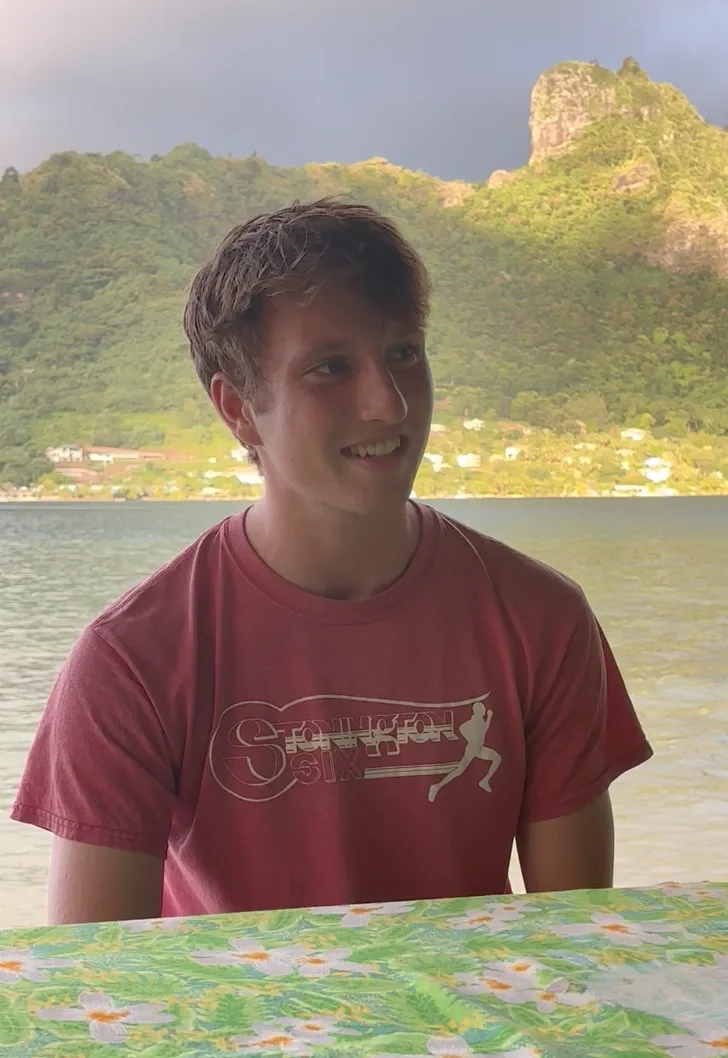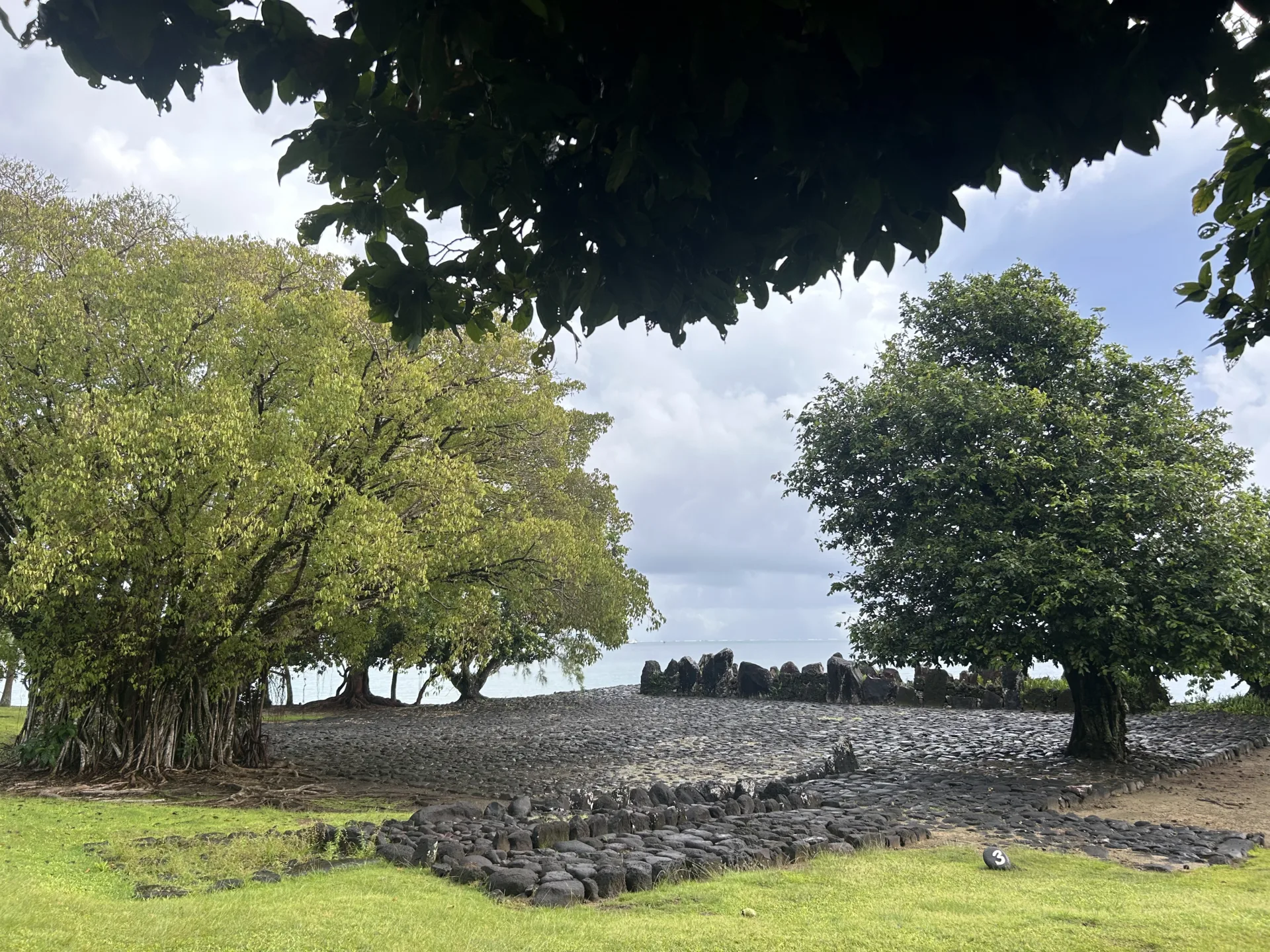Programs Blog
Henry on Saying Goodbye to the Ship, Dolphins at Night

Date: March 20, 2025
Time: 0630 local time (same time zone as Hawai’i)
Location: Mo‘orea, French Polynesia
Weather: Clear 75˚ F, wind 5 kts out of the east
The S321 Marine Biodiversity and Conservation class has completed their sea voyage from Aotearoa New Zealand to Mo‘orea, French Polynesia! This was a passage of six weeks and some 4,700 nautical miles, during which they spent a full month out of sight of land, often in quite heavy following seas as they sailed for science and to get a pelagic perspective on ocean management.
For the next two weeks, we are based at the Gump marine station on Mo‘orea, a field station right on the water and at the base of towering volcanic mountains. Gump is administered by the University of California Berkeley. Students are working on processing their oceanographic data, writing up their studies, and revising their articles and creative work for their edition of SEA Writer magazine. They will be sharing their scientific research work at a symposium, which will be streamed on Zoom to family and friends on Thursday May 29th. More details to come on this.
For this last portion of this class’s blog, we will be interviewing each student. We’ll start with Henry Penfold, from Bowdoin College.
After your month at sea out of sight of land, what did you all do after you cleared into Papeete for customs and anchored off Bora Bora?
These days flew by. We had pretty calm seas. So we were motoring a good part of that time, which is not quite as fun as sailing, but still lots of fun. And we did have a couple little outings. We were able to set the raffee at the top of the foremast, which was the last sail that we had not raised. Exciting to get that thing up.
It was a busy time. We stopped in Ra’iātea, which is an island beside Bora Bora, but much less populated. Incredible place. Incredible mountains. We visited a marae, a traditional temple there: a really cool, archaeological site. We learned a little bit of that history, which was amazing.
After Ra’iātea, the ship anchored off Mo’orea for your final night’s party and ceremonies. Then the next morning you took small boats ashore to the marine station. What was that like to end (for now) your time aboard the Robert C. Seamans?
Watching the boat sail away was not an easy thing. It was really tough! Great people on board that we’ve come to know over these weeks. It all ended so fast. I’m so grateful for that time on board. It’s nice that some of the students and staff are here in Mo‘orea, but a lot of great people on board that we’re missing, for sure.
It is amazing being here in Mo‘orea. The next two weeks are going to be fairly intense academically. This time is mostly allotted to working on our projects, crunching the data we collected, writing up our papers, working on our presentations for our symposium. And we also have some time built-in just to explore this place, which is really nice because it’s such an incredible landscape, new culture and everything, so it would be a shame not to see any of it.
Tell a story from your time at sea that has stuck with you.
So many. It’s hard to pick. But one particular magical moment I remember was early one morning in the Dawn Watch. I was standing lookout. It was a really quiet night, sailing along, engine off, really peaceful. It was a dark night. Not much of a moon. I started hearing some sounds, off to port. Some breathing. A pod of dolphins was coming up. This happens occasionally, but this was particularly incredible because as they started to ride the bow wave there was bioluminescence in the water. It was such a dark night that you couldn’t see the dolphins otherwise, just these sparkling outlines. This went on for a couple of minutes. It happened pretty fast, but I got people out from the lab, some people from the quarterdeck. I tried to wake a couple other people up, but by the time they got on deck, the dolphins were gone. That was a really special moment.

Recent Posts from the Ships
- Ocean Classroom 2024-A collaborative high school program with Proctor Academy
- Collaborations and Long-term Commitments: SEA’s Caribbean Reef Program Sets a Course for Coastal Programs that Compliment Shipboard Experiences.
- Sea Education Association students prepare for life underway using state of the art nautical simulation from Wartsila Corporation.
- SEA Writer 2022, Magazines From the Summer SEA Quest Students
- Technology@SEA: Upgrades Allow Insight into Ocean Depths
Programs
- Gap Year
- Ocean Exploration
- High School
- Science at SEA
- SEA Expedition
- SEAScape
- Pre-College
- Proctor Ocean Classroom
- Protecting the Phoenix Islands
- SPICE
- Stanford@SEA
- Undergraduate
- Climate and Society
- Climate Change and Coastal Resilience
- Coral Reef Conservation
- Marine Biodiversity and Conservation
- MBL
- Ocean Exploration: Plastics
- Ocean Policy: Marine Protected Areas
- Oceans and Climate
- Pacific Reef Expedition
- The Global Ocean: Hawai'i
- The Global Ocean: New Zealand